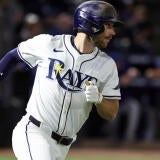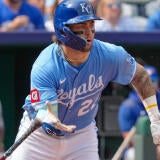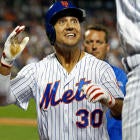| ||||||||||
2020 Fantasy Baseball Rankings Analysis 111-120: Case for and against targets like Corey Kluber, Brad Hand
The middle rounds are where it might be the right time to get your top closer. This group includes two of the best.
Circumstances have changed since our first round of draft prep. We're working with a much shorter schedule now, which of course changes the way certain players are valued. It was always the year of the pitcher, with the most skilled at that position enjoying a bump in value at a time when offense dominates the game. But now, even those with workload limitations are able to join in.
Consider this your reintroduction to the 2020 draft pool, accounting for all the changes that have taken place since and because of the coronavirus lockdown. Over the span of 20 articles, Scott White and Chris Towers look at the top 200 in Scott's Rotisserie rankings, highlighting the reasons for and against drafting each. It makes for a well-rounded education on every player, revealing critical details that more argument-based evaluations might conveniently leave out.
So if you want a crash course on this year's player pool, particularly in light of more recent events, you've come to the right place. We're going through Nos. 111 through 120. And you can find the rest right here: 1-10 | 11-20 | 21-30 | 31-40 | 41-50 | 51-60 | 61-70 | 71-80 | 81-90 | 91-100 | 101-110 | 111-120 | 121-130 | 131-140 | 141-150 | 151-160 | 161-170 | 171-180 | 181-190 | 191-200
No. 111-120
The Case For: The guy finished top three in AL Cy Young voting four times in the five years leading up to 2019, a year that was obviously wrecked by injury. Given how long he resided near the top of the starting pitcher rankings, the discount this year seems pretty extreme. Yes, his numbers were bad for the one month he was healthy, but he was in good company there. Pitchers like Noah Syndergaard, Chris Sale, Eduardo Rodriguez, Aaron Nola, Lance Lynn, Brandon Woodruff and Yu Darvish all had an ERA over 5.00 last April.
The Case Against: Let's suppose the same phenomenon that led to last year's home run explosion (a change in seam height on the actual ball) also contributed to an adjustment period for all the high-end hurlers listed above. Maybe, then, Kluber simply didn't get his chance to recover. The problem is that he already had his share of detractors heading into 2018 because of a drop in velocity and swinging-strike rate. And now he's coming back from a broken arm and pitching at a new Rangers ballpark that may not play well for pitchers. He leaves a lot to wonder about, and the pool of potential high-end pitchers is deep enough that it's easy just to leave those questions for someone else. -Scott White
| ||||||||||
The Case For: After another season with a full-time closing gig, Hand now has an established track record in the role. He wasn't able to deliver a third straight season with 100 strikeouts because of a bout with arm fatigue in the second half, but his 13.3 K/9 was in line with the previous two seasons and obviously speaks to his effectiveness. At a tumultuous time for an ever-tumultuous role, Hand would appear to be one of the more bankable options.
The Case Against: A glance at his final numbers the past three years would indeed suggest Hand is bankable, but he was anything but while pitching through those arm issues in the second half, putting together a 6.08 ERA in 14 appearances over the final two months. It's led some to question his hold on the closer role. Even if Hand bounces back as hoped, the Indians' willingness to deal off expiring contracts even while in contention (see Trevor Bauer and Corey Kluber) could mean he's not long for the team. -Scott White
| ||||||||||||
The Case For: Conforto gets on base a bunch and hits for power, and he does it all in a pretty good lineup. He's not a superstar, but he's a reliable source of 30 homers, and there might still be potential for a random year when he hits .290 and is an MVP candidate.
The Case Against: Conforto doesn't really stand out anywhere. He might have an outlier year where the average is higher, but your expectation should be that he hits in the mid-.200s, with the potential for a season where he also hits .230 or .240. A .260 hitter with the capacity for 30 homers in a full-length season just isn't that hard to find, and you're passing on players with more potential at this spot in the draft. -Chris Towers
| ||||||||||
The Case For: As long as you keep expectations in check, Wheeler is a solid mid-rotation Fantasy arm. He'll probably give you a mid-to-high 3.00s ERA and a strikeout per inning, and hopefully the Phillies will provide a bit better defense than he got with the Mets. Since coming back from Tommy John surgery, he has thrown at least 182 innings and 29 starts in consecutive seasons, so hopefully you can just plug him into your lineup and forget about it.
The Case Against: Someone in your league probably sees more upside in Wheeler than that, which means you'll have to reach for him if you want him. For the second year in row, Wheeler significantly lowered his ERA in 2019, and that could lead some to believe there's another level yet to reach. But it's worth noting his strikeout rate actually went down significantly despite that apparent improvement, while his WHIP barely budged. I just don't see the upside here. -Chris Towers
| ||||||||||
The Case For: Putting together his first healthy season in five years, Ryu led the majors with a 2.32 ERA, and if you add his 15 starts from 2018, he has a 2.21 ERA over his past 44 starts. Granted, what he did in the second half, putting together a 3.18 ERA and 1.15 WHIP, is more in line with his FIP and xFIP and perhaps a more realistic expectation for a full season, but … it's still pretty good. He may not measure up to the aces in terms of strikeout ability, but he dominates in other ways, ranking second among qualifiers in walk rate and ninth in ground-ball rate.
The Case Against: Did I mention 2019 was his first healthy season in five years? Yeah, he'll be 33 this year, so maybe we shouldn't be penciling him in for a full workload, shortened season or not. He's also pitching for the Blue Jays now, which should make wins harder to come by, and wins remain the most valuable stat for a starting pitcher even though they're difficult to predict. Though his impact could be significant for a pitcher drafted in his range, Ryu just isn't someone you can rely on. -Scott White
| ||||||||||||
The Case For: Laureano's numbers couldn't have translated any cleaner from a late-season look in 2018, meaning he indeed lived up to the billing as a player who could make a worthwhile contribution in all five categories. His line-drive rate was again on the level of some of the best in the majors, ensuring him a high BABIP, and he was thrown out just twice on his 15 stolen base attempts. With his competent defense in center field and his even splits against righties and lefties, the Athletics have every incentive to continue playing him every day.
The Case Against: Laureano's plate discipline is less than ideal, which means he pretty much has to remain an outlier in BABIP to make a worthwhile contribution in batting average. The stolen base total might have been a little underwhelming compared to his 2018 pace, and there's of course no guarantee it remains a regular part of his game moving forward. Because Laureano doesn't have a standout skill other than hitting line drives, he'll need to sustain everything to hold his stock, which is a tough ask for a player entering his second full big-league season. -Scott White
| ||||||||||
The Case For: Jansen is still the undisputed closer for a surefire contender, so you can rest assured the save chances will be there. That's no trifling detail at a time of widespread bullpen uncertainty. He of course has his track record of dominance, compiling a 2.07 ERA, 0.84 WHIP and 13.7 K/9 over a six-year span that ended in 2017, but his 1.06 WHIP and 11.4 K/9 last year were still respectable. The drop off hasn't been drastic enough for the Dodgers to consider making a move, especially if his work with Driveline Baseball in the offseason helps him recapture some of his former stuff.
The Case Against: Who are we kidding? The Dodgers are one of the most forward-thinking organizations in the game. They'll pull the plug on Jansen quicker than most any other, and the reports of them being in the mix for virtually every high-end reliever who hits the market are telling. Jansen's velocity decline the past two years has made him more susceptible to the long ball, which played no small role in his eight blown saves last year, and his 4.44 ERA in the second half seemed to make manager Dave Roberts hesitant to turn to him with the game on the line in the postseason. Jansen may still be able to get by as a closer, but he's not a lockdown one anymore. -Scott White
| ||||||||||
The Case For: Josh Hader's 138 strikeouts were again an outlier among full-time relievers last year. But Liam Hendriks' 124 came closer than anyone else's. The nine-year veteran claimed the closer role from an injured Blake Treinen in late June and never gave it back, riding his faster-than-ever fastball to unprecedented results. He's the undisputed closer for the Athletics now — a team with legitimate playoff aspirations. Even if you're skeptical of the performance, honestly, how many trustworthy closing options are there?
The Case Against: Let's see ... longtime so-so reliever takes a turn for the dominant, making the case seemingly overnight that he's now some lockdown closer. Now where have we heard this before? Oh, that's right — Treinen, for these same A's just a year before Hendriks. And you see how that one turned out. Apparently, it was a new workout program involving more long toss that brought Hendriks' fastball to new heights, but a reliever's sample of innings and pitches thrown is so small that skepticism for an outlier performance is always warranted. -Scott White
| ||||||||||
The Case For: Improving his production for a third straight year, Rogers genuinely had the look of a closer during a season when he primarily served as one, upping his strikeout rate in a way that didn't diminish his natural ground-ball tendencies. Of his 30 saves, 18 came in the second half, solidifying his standing as the bullpen ace for a team hoping to cash in with an AL Central title.
The Case Against: The Twins were consistently reluctant to go all-in on Rogers as their closer in 2019, forcing him to split save chances with Blake Parker early and then throwing the occasional one Sergio Romo's way down the stretch. The left-hander was less a closer than a late-inning workhorse, often being asked to pitch multiple innings, and with Romo back in the fold (as well as other respected options like Tyler Duffey and Tyler Clippard), it's possible Rogers' save total could underwhelm even if he remains the first option for the ninth inning. -Scott White
| ||||||||||||
The Case For: Between the majors and minors, Biggio racked up 22 homers and 19 steals, and he actually ran even more in the majors — a great sign. There just aren't many players with 20-20 potential these days, and that probably isn't Biggio's ceiling. Selective almost to a fault, Biggio could take a huge step forward with a bit of a more aggressive approach early in counts. There's star potential here.
The Case Against: There are also big red flags. The power and speed are great, but he needs to make more contact and hit better than .234 to make them play up. He was extremely hit or miss in the minors, but more often than not didn't really hit for much average. It's a combustible package of skills and deficiencies. -Chris Towers




































